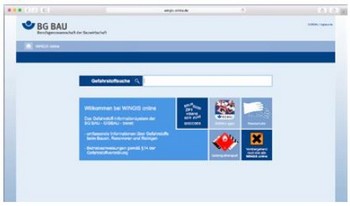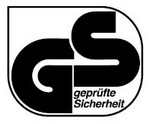Abschnitt 2.2 - 2.2 Principles applicable to the office businesses sector
 | Statutory references |
|---|---|
Rights to co-determination
| |
Employee representative body
Should your company have a works or staff council, you are obliged to involve it in many issues relating to occupational safety and health. The general tasks of the works or staff council include monitoring observance of the regulations in force for the protection of employees, and also the promotion of occupational safety and health measures. All occupational safety and health measures are covered by the rights of participation and co-determination.
It may be constructive for the works or staff council, employee representatives and/or the severely disabled employees' representative to be informed of and involved in many occupational safety and health issues at an early stage.
Cleaning
Regular cleaning work is doubtless a given in your company. Are you aware that cleaning agents may also contain hazardous substances? Cleaning agents frequently contain solvents, acids or alkalis. Ensure therefore that wherever possible, cleaning agents are used that do not contain hazardous substances. Should you outsource cleaning work, agree this requirement with the service provider.
Important information on the ingredients of cleaning agents and the hazards that they may present can be found in the safety data sheets of the products concerned. The products' manufacturers are required to make these safety data sheets available. The safety data sheets contain information on use of the cleaning agents and contact with them, and on measures to be taken to prevent hazards. They serve as an important resource for the generation of plant procedures and the provision of instruction to employees.
Note: Many safety data sheets and further resources (including for cleaning agents) are
available in the Wingis online database.  www.wingis-online.de www.wingis-online.de |
|---|
 |
Ensure that cleaning agents are not stored together with foods (for example the descaler on the shelf next to the sugar and coffee in the break room). Cleaning agents must be stored such that only the persons tasked with cleaning work have access to them. They must be stored in closed containers. If at all possible, the original containers or original packaging should be used. Containers must not be used that could be confused with those for other substances or products owing to their shape or marking.
Have the electrical equipment used for cleaning work (e.g. vacuum cleaners) checked regularly to ensure its safe condition and electrical safety.
Cleaning of work equipment, hygiene
All work equipment should be cleaned regularly. Observe the manufacturer's cleaning instructions and ensure that the cleaning agents used are not harmful to the skin.
The sharing of keyboards, mice or headsets by several persons may cause pathogens to be transmitted between them.
Wherever possible, provide individual employees with work equipment for their use alone. If workstations are used by several persons, the workstation must enable a different keyboard, mouse and headset to be substituted quickly. Alternatively, ensure that the work equipment is cleaned more frequently, ideally at the beginning or end of the working shift.
Preventive occupational medical care
Office workers typically work at VDU workstations. You must offer these employees optional preventive occupational medical care at regular intervals. This care always includes a consultation with a physician and, if desired by the employee, an eye test.
You must also enable your employees to request preventive medical consultations in the event that they suspect a connection between health complaints and their work. You must comply with such requests, unless evaluation of the working conditions and the protective measures in place enable the risk of harm to health to be ruled out.
The results of the occupational medical consultations are made available only to the employee. The employee in turn decides whether this information is made available to other parties.
Breaks - interruption of VDU work
FIn order for office work to be productive and healthy, tasks at a VDU station should ideally be organized such that they are regularly punctuated by other tasks or by rest breaks. The requirement for VDU work to be interrupted regularly by discrete tasks that do not need to be performed at the screen is met by the concept of mixed work. In this concept, different tasks with different requirements are combined, as a result of which imbalanced stresses are avoided. This particularly concerns stresses upon the locomotor apparatus, the eyes and the mind.
During office work, attention should be paid to varying the body posture.
Should alternation between discrete tasks associated with different stresses not be possible, the employees should be able to punctuate their daily work at the VDU station with regular, brief breaks.
Several shorter rest breaks are more conducive to recuperation than fewer, longer rest breaks of the same total duration. Merging of the rest breaks or saving them up in order to shorten the working day negates the recuperative effect and must therefore be avoided. It is advantageous for exercise to be performed within the rest periods.
Rest periods of at least 5 minutes per hour have proved effective in practice.
Accessible work equipment
Facilities, products and software must be accessible if they are also to be used independently by persons with disabilities. "Accessible" in this context also has the meaning of "universally usable". In other words, accessible solutions are not dedicated solutions for persons with disabilities, but an extended usage concept that wherever possible includes all target groups. For example, the software used in your office should permit adaptation to the needs (e.g. contrast, display size, form of information display) of the broadest possible potential user group.
| Information processing systems, acoustic and visual sources of information and communications
facilities are accessible when they can be reached, accessed and used by persons with
disabilities in the normal way, without particular difficulty, and without requiring
assistance from other parties. Definition of accessibility (paraphrased) in accordance with the German disability discrimination and general equal treatment act (BGG), Section 4 |
|---|
 The GS mark demonstrates compliance with the minimum safety and ergonomics requirements
and serves as a reference during procurement. Always procure work equipment bearing
the GS mark and obtain the associated certificate.
The GS mark demonstrates compliance with the minimum safety and ergonomics requirements
and serves as a reference during procurement. Always procure work equipment bearing
the GS mark and obtain the associated certificate.

Monitors, keyboards, mice, and also office furniture and lights are examples of work equipment in this context.
Protection of non-smokers
Tobacco smoke contains a numerous substances many of which are classified unequivocally as carcinogenic. As an employer, you therefore have a duty to protect your non-smoking employees effectively at workplaces against the health hazards of tobacco smoke. You can meet your duty of protection by means of structural, technical or organizational measures. Smokers and non-smokers may for example be separated, smoking zones created, or ventilation measures implemented. You can also impose a general smoking ban. Observe the workers' representation's right of co-determination where applicable. No obligation exists to ensure that smokers may smoke unhindered. It is advantageous for such measures to be combined with campaigns to encourage giving up smoking.
Consider fire safety when setting up a smoking zone. Provide suitable, fireproof and ideally self-extinguishing ashtrays. Ensure that ashtrays are emptied into suitable receptacles. Smoking zones must be kept free of any flammable materials.
